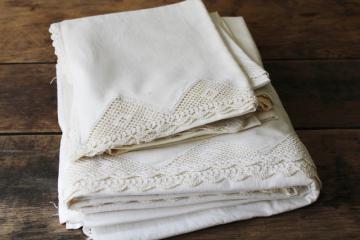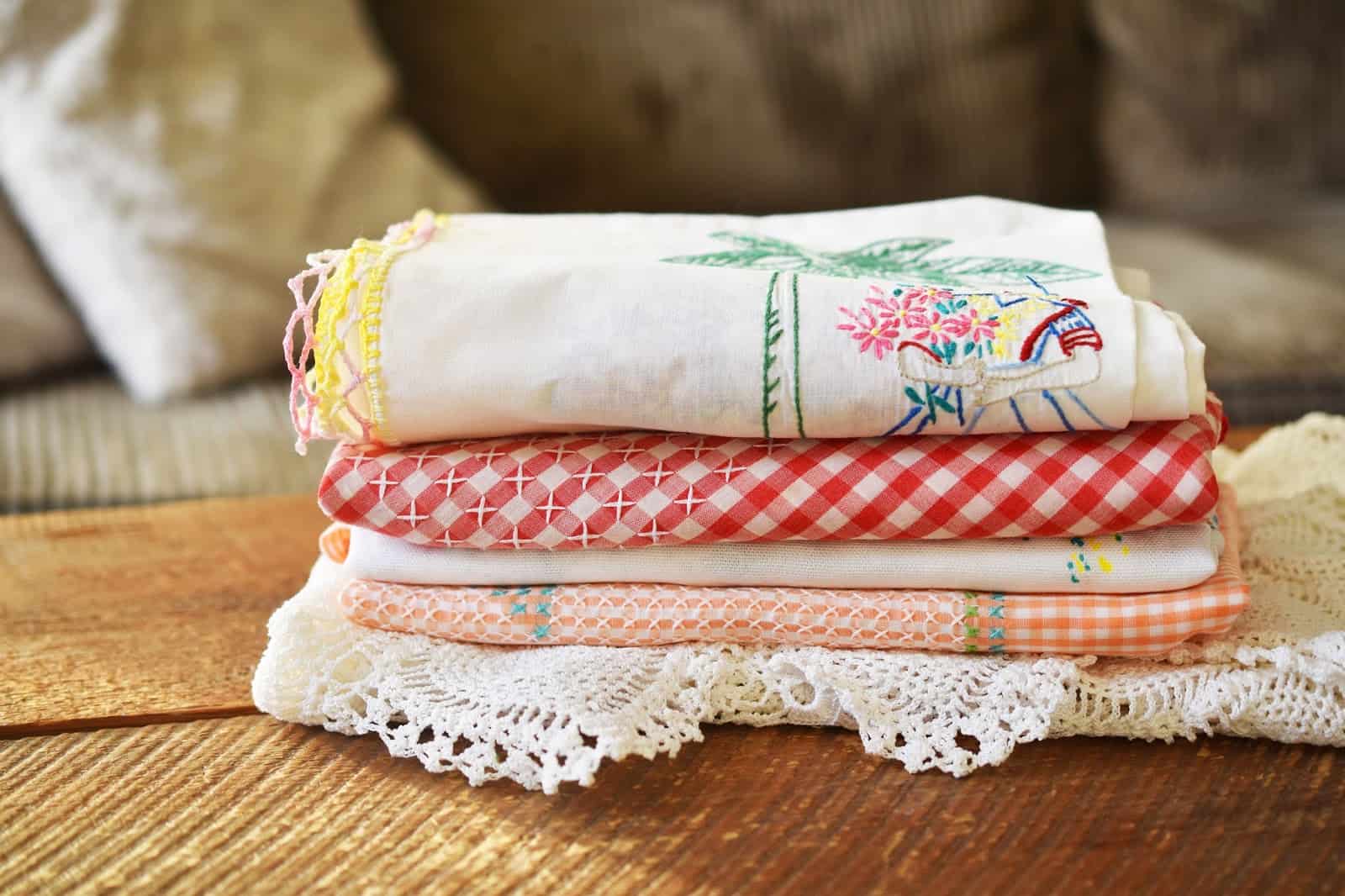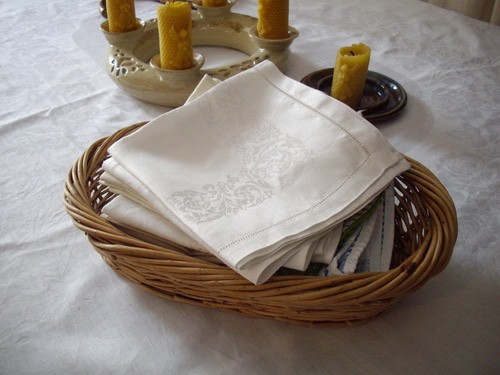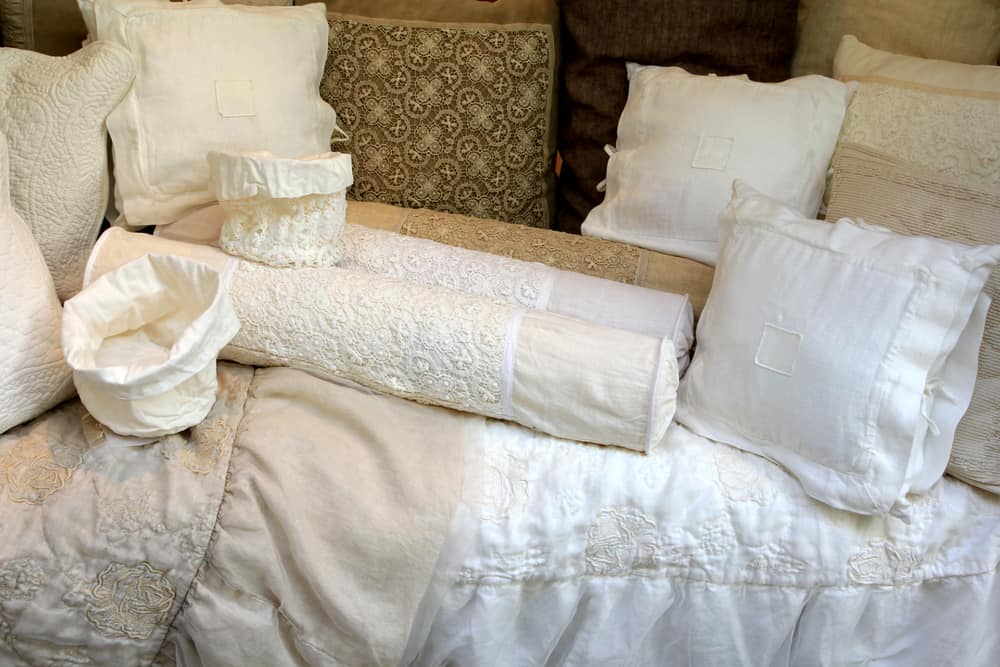I am sure that some of you had the chance to travel far and beyond and have seen markets full of vintage furniture and handcrafts. But, when people talk about antiques and vintage items, the first that comes to your mind is furniture, dishes, jewelry, and clothes.
However, in the past few years, most antique stores started focusing on vintage linens, beddings, curtains, tablecloths, and all kinds of delicate textiles that look absolutely amazing. These are some of the most collectible and fascinating handicrafts you can find nowadays.
The fact that every piece is manually embroidered on beautiful old fabric, makes you think about their actual worth? Let’s learn how to recognize real vintage linens and antique textiles, where to find them, and how to handle them.
Table of Contents
What Are The Types Of Vintage Linens?
Not all vintage linens are the same. Many people don’t know that there is a wide variety of different antique and vintage fabrics you can find in antique shops and online. That is why this article is starting with some must-know basics.
For starters, we can sort vintage fabrics into so many categories however lets’ be practical and make only three categories:
- Vintage bed linens.
- Vintage tablecloths and napkins.
- Other vintage fabrics like towels, tea towels, vintage handkerchiefs, doilies, and lace.
Vintage bed linens

The bedroom is the most important room in the whole house if you ask me. Nothing can make you feel so good and relaxed after a busy work day as coming home and hopping in your cozy and freshly made bed.
Therefore, it is completely understandable, why we girls, spend so many hours and so much money choosing decorations and bed linens for our bedrooms. In the past, girls would do all that on their own.
They would spend months and years working on their hope chest (the one that goes with them when they get married), filling them with all king of handcrafted fabrics including the following pieces:
- Bedspreads and covers – vintage bedspreads and covers can make your bedroom look warm and cozy, giving that extra special and carefree vibe. Most vintage bed linens are made with monograms and emblem patterns from a specific area and era. The bed covers were made from silk, cotton, and handmade lace, and decorated with hand embroidering and crocheted details.
- Pillowcases – Personalized pillowcases and handkerchiefs were very popular items in the early 1900s. If you are lucky enough you’ll find a lot of different motifs and designs from that period. Most pillowcases were made from cotton with handmade lace edges, with subtle and delicate embroidery details that represent flowers, birds, fruits, and animals like kittens and dogs.
- Quilts – Nothing will warm you up on long winter nights like a good old quilt! Not only that they are very useful, but they are also incredibly stylish and beautiful. A quilt in a good condition and entirely made by hand will serve you for years if you know how to take care of it.
Vintage table linens

Besides the beds, tables and windows were usually decorated with beautifully handcrafted table runners and curtains. These items were usually passed down in the family as a heritage to use on special occasions, so most of these specimens are preserved in perfect shapes.
- Vintage tablecloths – Tablecloths and table runners were made in so many different shapes and sizes. Usually, they were decorated with personalized crochet details, monograms, hand embroidery, and handmade lace. I bet that your grandma’s house has at least one handcrafted table runner.
- Vintage kitchen towels – These are hard to find in a good condition, considering these were made to be used on a daily basis. However, no matter whether they had an actual purpose or not, these pieces of fabric were usually beautifully decorated. Hand embroidered with flowers, fruits, veggies, and other kinds of foods.
- Vintage napkins – These usually came in a matched set and they are also very hard to obtain nowadays since most were used. They were made from cotton, damask, or linen with hand-embroidered details.
- Antique tea towels – Just like tablecloths and runners, these as well were made in different styles and patterns. You can find these sets in perfect condition since they were used rarely and on special occasions when families entertained Sunday dinners, for instance.
Other decorative antique fabrics

There are other types of vintage linen that many homes had back in the 1930s. Those are vintage hand towels, handkerchiefs, and doilies. Monograms were especially popular at that time, they added a touch of luxury and glamor to the overall interior look.
Most of these handcrafts are made from damask, cotton, and linen, and decorated with unique embroidery and handmade lace. You can also find handmade doilies and dresser scarves that were used to decorate the surfaces of wood dressers and furniture.
How to use vintage linens?
I get that you adore your new old linen tablecloths and towels, however, they can’t withstand regular daily use. It is better to use it for small occasional gatherings where you won’t serve saucy food and wine.
Remember products like wine, coffee and tomato sauce, and chocolate will stain your linen and ruin them for good. You can use vintage towels and runners as a decoration but keep in mind that dust and sun rays will take their turn on the fabric and make them yellowish.
Are Vintage Linens Valuable Collectibles?
Antique linens are miniature art pieces that will make you feel nostalgic about the old days when everything was modest and minimalistic. If you choose to decorate your home with vintage fabrics you’ll create a cottage-looking ambiance that you can’t achieve with modern linen.
Decorative appeal
A decorative appeal is the most important factor that will determine how valuable your antique item is. When we talk about vintage linens, handmade laces, fine crochets, and embroidery can be very valuable if they remained in a good condition.
Possess a story
Also, antique linen tells a story, so if your vintage fabrics have some kind of history and unique origin this will increase their value a lot. You’ll need to know the country from which the linen originated.
For instance, linens that came from England, Italy, and France are in higher demand than linen that came from China, especially after the 1930s. On the other hand, fabrics that originated from China before the 1900s are very valuable, as long as they are in good condition.
Other factors that affect the value of the vintage linens
- Condition – logically damaged linens aren’t in demand, any kind of stains, tears, or pulls, will lower the value significantly.
- Scale – if you own a larger high-quality piece of vintage textile it will be worth more than a smaller one.
- Age – like with all other antiques, the older the piece is, the value is higher.
- Usage – For instance bedspreads and tablecloths are more valuable considering that they still can be used compared to items like doilies and handkerchiefs.
How to properly take care of vintage linens?
Vintage linens, so delicate, so dainty and beautiful I bet you get anxiety attacks when thinking about using them. What if someone stains it? Or god forbid pull out the string, make a hole, or any other damage.
Now you are thinking how on earth will you wash and clean something that is almost a century old? That can’t be washed in a machine, so what then? In the rows below you’ll find instructions that will help you learn how to take care of your precious vintage linens.
Let’s start with the washing process. When you decide to wash your antique fabrics you can choose some of these options:
Soak embroidered linens
Naturally, you want to keep your linens as white as possible, but using industrial bleaches and soap will harm the fabric. Instead, choose to soak your linens in lukewarm water, never hot, for about 15 minutes. After that add some mild washing soap that is phosphate-free and gently swish them. Rinse it thoroughly and let it dry naturally.
Use natural bleach
As I already said submerging antique fabrics in industrial harsh bleaches is a crime. However, some stains can only be bleached out, in that case, you’ll need to use natural ingredients that won’t destroy the fabric. Use a combination of lemon juice and salt, then hang the linen outside to air dry. When it’s all dry, rinse it with warm water and air dry again.
Use Engleside’s Restoration fabric cleaner
If lemon juice and salt don’t do a trick don’t be tempted to wash your linen in a washing machine. The cycle and the soap we use in washing machines are simply too intense for a delicate fabric like this. However, it is recommended to try mixing three scoops of Restoration cleaner per gallon of water and let your linen soak for 15 to 20 minutes. Remove it, wring out the water and repeat the soaking process but this time live it in for eight hours. Rinse out the linen and air dry it.
Take it to professionals
If you don’t want to take any risk then you should take it to dry cleaning. Especially if you notice some holes and tearings. Send them to your trusted cleaner, better to be safe than sorry.
Iron only before the use
The lines might be old, but if it’s still in good condition you can iron them from time to time. Spritz the linen with water before you iron it so you can handle all the folds with ease. In case your linen is embroidered just place the linen between two thin towels, then use the iron.
Where to find vintage linens?
Internet as always should be the first place where you will look, after that check out the local thrift shops and antique stores, as well as flea markets. You’ll be able to find a lot of good stuff for very affordable prices, so here are just some of the places where you can find them:
- eBay – obviously eBay is the place where you can find anything imaginable, so try your luck with vintage fabrics.
- Etsy – here you’ll find a wide variety of vintage linens, for very affordable prices. Usually, here people sell plain and monogrammed fabrics.
- Chairish – this is a great source for all who are looking for vintage and modern decorative fabrics. However, this web mainly sells pricier pieces, but you can still find decent ones as well.
Conclusion
Vintage is in fashion again. Stop by your grandmother and look for forgotten sheets, pillowcases, tablecloths, runners, napkins, or anything you can use to enhance your home’s decor.
Use granny’s old embroidered towels on old wooden ladders with some decorative string lightning to create a boho atmosphere. Or maybe decorate your bed and pillows with old-fashioned pillowcases and quilts.
Be bold and try anything, come up with your own project idea, and make sure you share them with us!
